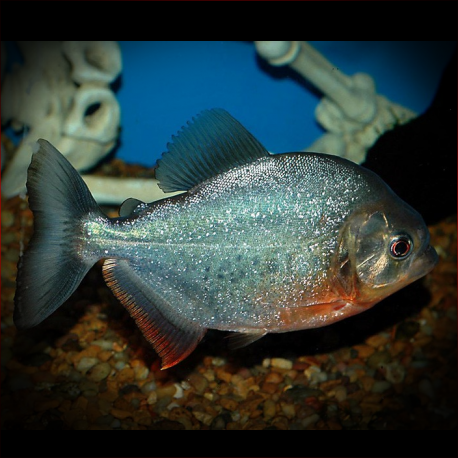More info
Datasheet
| Minimum Tank Size | 10000 litres / 2641.72 US gallons |
| Maximum Size | 35.0cm / 13.78inches |
| Temperature | 24°C / 75.20°F - 28°C / 82.40°F |
| Hardness | 2.02dgH / 36ppm - 12.05dgH / 215ppm |
| pH | 5.5-7.5 |
General Description
The Pygocentrus nattereri, commonly known as the Red Bellied Piranha, is a well-known freshwater fish recognized for its reputation as a fierce predator capable of quickly consuming flesh. They possess a compressed body shape, long dorsal fin with 16 or more rays, and have sharp serrae formed by modified abdominal scales on the ventral surface.
Aquarium Setup
For optimal care and maintenance of the Red Bellied Piranha, a tank size of at least 10,000 litres is recommended. Suitable substrates include standard aquarium gravel or sand, and while some aquarists prefer bare-bottomed tanks, decorations are based on personal preference. It is advisable to employ over-sized external filters, perform weekly water changes of 30-50%, and handle maintenance activities with caution due to the fish's aggressive nature.
Behaviour
Red Bellied Piranhas are best kept either as solitary individuals or in groups, with juveniles often forming aggregations while older individuals exist in loose groups with dominance hierarchies. Despite their predatory nature, adults generally do not prey on much smaller fishes. Therefore, purchasing a single specimen or a group of 5 or more individuals is recommended, with the latter being preferable.
Feeding and Diet
Considered opportunistic generalists, Red Bellied Piranhas have a diet consisting of live fishes, aquatic invertebrates, insects, nuts, seeds, and fruits. Their feeding habits include attacking sick or dying fishes, scavenging carcasses, and even consuming live prey such as river shrimp or earthworms. It is essential to provide appropriate food items based on the age of the fish, avoiding mammalian or avian meat to prevent health issues.
Reproduction & Dimorphism
In the wild, Red Bellied Piranhas reproduce twice a year, and breeding in aquarium settings can be facilitated by providing suitable conditions such as cool water changes. Sexual dimorphism is exhibited in this species, with females generally growing larger and possessing a more rounded body shape compared to males. Breeding pairs exhibit specific behaviors, such as nest-building and egg guarding, with fry requiring diligent care and feeding.
Habitat and Distribution
Red Bellied Piranhas are commonly found in various habitats throughout the Amazon basin, including major river channels, oxbows, floodplain lakes, and artificial lakes formed by dams. They can also be located in the Río Essequibo, Río Paraná, and Río Uruguay, among other regions, with their type locality being in Cuiabá and Mato Grosso, Brazil.

